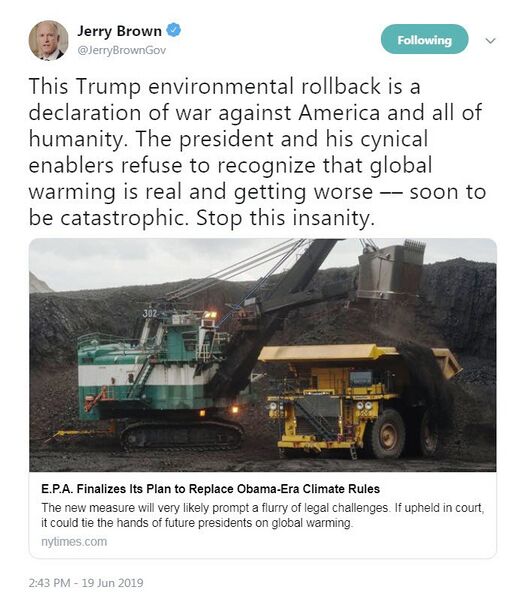File:Jerry Brown re EPA - 19 June 2019.jpg

Original file (699 × 798 pixels, file size: 126 KB, MIME type: image/jpeg)
• https://www.latimes.com/politics/la-na-pol-trump-epa-weaken-clean-power-20190619-story.html
• https://www.nytimes.com/2019/06/19/climate/epa-coal-emissions.html
Trump EPA finalizes rollback of key Obama climate rule that targeted coal plants
The U.S. electricity sector needs to cut its emissions 74 percent over 2005 levels by 2030 to avoid hitting the 2-degree mark, according to the International Energy Agency. Overall, the country must slash greenhouse gas emissions 48 percent by 2030, according to the IEA’s Brent Wanner, with the deepest cuts coming from the power sector because cheap alternatives to coal are readily available.
Jason Bordoff, founding director of Columbia University’s Center on Global Energy Policy, said in an interview that his group had found that more aggressive action by U.S. officials such as a nationwide carbon tax of $50 per ton could cut the country’s greenhouse gas emissions by 40 percent over the next decade.
“Market forces don’t do that by themselves,” Bordoff said. “You need regulations.”
A paper published this year by researchers at Harvard, Boston University and Syracuse University, as well as Resources for the Future, said that the agency’s new rule might increase efficiency at individual coal plants, but then they might end up operating more frequently and for a longer time.
The researchers found that as many as 28 percent of the plants affected could actually produce higher overall emissions in 2030 than if there was no federal policy in place. They also estimate that emissions of sulfur dioxide and nitrous oxide could rise in nearly two dozen states by 2030 compared with having no new federal regulation.
>The Affordable Clean Energy (ACE) rule, the US Environmental Protection Agency's (EPA) proposed replacement of the Clean Power Plan (CPP), targets heat rate improvements (HRIs) at individual coal plants in the US. Due to greater plant efficiency, such HRIs could lead to increased generation and emissions, known as an emissions rebound effect. The EPA Regulatory Impact Analysis for the ACE and other analyses to date have not quantified the magnitude and extent of an emissions rebound. We analyze the estimated emissions rebound of carbon dioxide (CO2) and criteria pollutants sulfur dioxide (SO2) and nitrogen oxides (NO X ), using results from the EPA's power sector model, under the ACE in 2030 at model coal plants and at the state and national levels compared to both no policy and the CPP. We decompose emissions changes under a central illustrative ACE scenario and find evidence of a state-level rebound effect. Although the ACE reduces the emissions intensity of coal plants, it is expected to increase the number of operating coal plants and amount of coal-fired electricity generation...
• https://www.greenpolicy360.net/w/Governor_Jerry_Brown
○
File history
Click on a date/time to view the file as it appeared at that time.
| Date/Time | Thumbnail | Dimensions | User | Comment | |
|---|---|---|---|---|---|
| current | 19:09, 19 June 2019 |  | 699 × 798 (126 KB) | Siterunner (talk | contribs) |
You cannot overwrite this file.
File usage
The following 3 pages use this file:
- Air Quality
- Air Pollution
- Antarctica
- Anthropocene
- Atmospheric Science
- California
- Climate Change
- Climate Migration
- Climate Policy
- Desertification
- Earth Imaging
- Earth Observations
- Earth360
- Earth Science
- Earth Science from Space
- Earth System Science
- Ecology Studies
- Eco-nomics
- Education
- Energy
- Environmental Laws
- Environmental Protection
- Environmental Security
- Environmental Security, National Security
- Externalities
- Extinction
- Fossil Fuels
- Global Security
- Global Warming
- Green Networking
- Green Politics
- Health
- INDC
- Maps
- Money in Politics
- NASA
- NOAA
- Natural Resources
- Networking
- New Definitions of National Security
- New Economy
- New Space
- Oceans
- Ocean Science
- Planet Citizen
- Planet Citizens
- Planet Citizens, Planet Scientists
- Renewable Energy
- Resilience
- Sea-level Rise
- Sea-Level Rise & Mitigation
- Solar Energy
- Strategic Demands
- Sustainability Policies
- Threat Multiplier
- United Nations
- US
- US Environmental Protection Agency
- Water Quality
- Whole Earth
- Wind Energy
- Youth